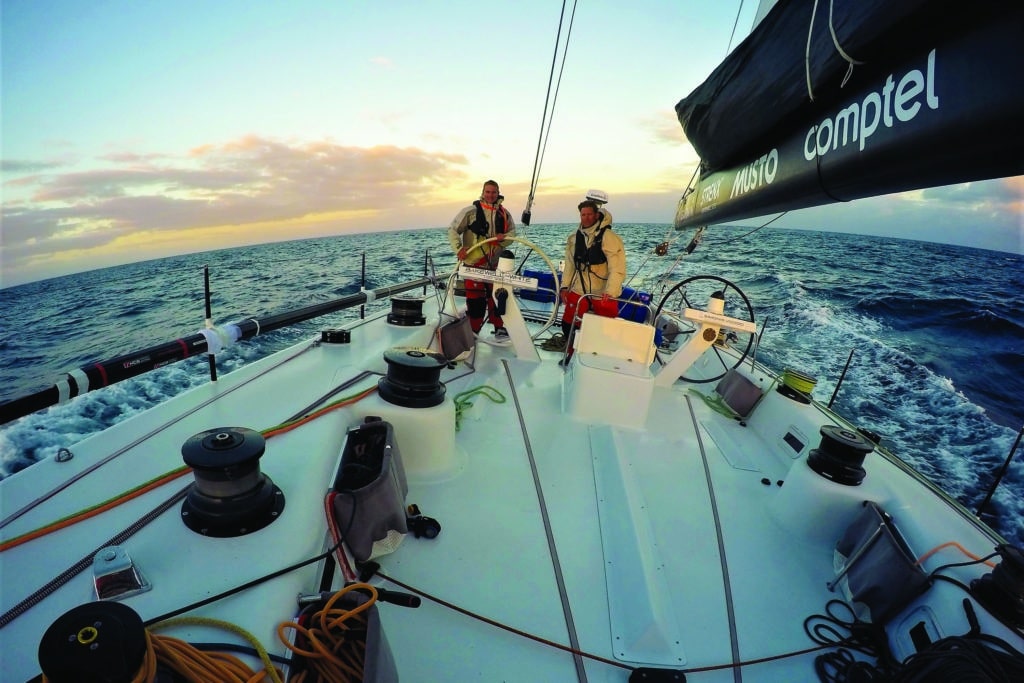
I stroll the Key West waterfront, gazing with covetous eyes at the big maxis with three pedestals and towering five-spreader rigs. These are carbon machines with materials and systems so exotic, they haven’t yet trickled down to the boats on which I race. As I admire, I long for a bigger, faster ride. I see their crews peacocking down the dock in their team gear, and feeling like a skid-row kid standing outside the country club, I tell myself, “One day, I will belong.”
It’s here at Quantum Key West Race week where I befriend Rodney Keenan, owner of Evolution Sails, and as it turns out, a watch captain on the supermaxi CQS, a 100-foot, all-carbon, push-button, canting-keel, winged and foiled boat of my dreams. I now have a guy on the inside.
Weeks later, after serendipitously shredding the jib on my boat back home, I reach out to Keenan for a quote, as well as an attempt to weasel a ride on CQS some day. As part of a manufactured coincidence, I will be on my honeymoon for the start and finish of the 2016 Rolex Sydney Hobart Race. I agree to buy the sail, but on one condition: a ride on CQS. He offers me a spot on the return delivery crew from Hobart to Sydney.
After a few weeks of traveling around Australia with my wife, I get a call from CQS boat captain Chris Skinner to come and meet the crew. I walk toward the tallest mast I’ve ever seen, nervous, hoping to make a good impression.
When I leave my wife on Boxing Day to fly to Hobart, I believe the delivery will be to Sydney and I will be back by New Year’s Eve, but due to gear failures during the race, CQS will instead sail to Auckland for repairs.
Departing Hobart in benign conditions, the breeze builds to 35 knots, destroying our plans for a New Year’s celebration. While the rest of the world uncorks champagne to ring in 2017, the delivery crew aboard CQS is in crisis mode. The rudder bearing is shearing apart, and with the potential to lose it in a storm 500 miles off Tasmania, we are worried about a different sort of bubbles. We spend the first moments of the year reducing sail and jury-rigging the rudder to prevent it from dropping out of the boat. Skinner inspects the rudder bearings and realizes they’re coming apart. We cannibalize hardware from the spray hood to through-bolt the rudder cap and prevent the bearing from pushing up through the deck. Our main concern, however, is minimizing the loads on the rudder and avoiding a wipeout. From a top speed of 25 knots during the day, our new speed limit is 14 knots.
Skinner doles out response assignments, should we lose the rudder, driving home the severity of our predicament. We are more than 500 miles from land without a working AIS, and if we lose the rudder, the boat will sink quickly. I sleep with my life jacket close by and my foul weather gear on, with my wallet and passport in my pocket in the event we have to abandon ship, or worse, so my body can be identified.
Over the next few days, conditions ease, and we no longer wince every time the rudder creaks. A few light-air days extended our trip, and we find ourselves nearing the end of our food and fuel. No matter how slow and painful, we have to sail to conserve fuel because the engine is required for the hydraulic system to power the winches, cant the keel, and adjust rig tune.
We approach Auckland on fumes, both physically and mechanically, having finished the last of our food: white rice and ketchup. For seven days, I’m part of something special: sailing 1,500 miles with a top crew on one of the most advanced monohulls on Earth, and I’m sorry to see it end. I’ve finally tasted the good life.









